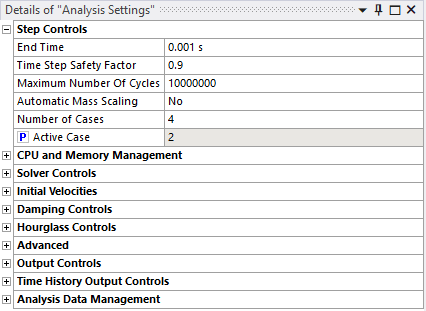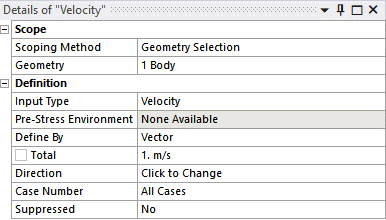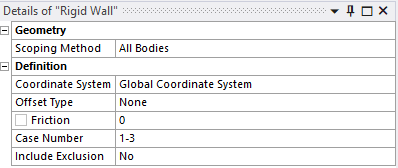The Number of Cases property is set under the Step Controls section of Analysis Settings. This property defines the number of cases. When greater than 0, the CASE input argument is passed to the solver to enable initialization of a multiple case solve. The default value is 0, which indicates that the *CASE command is not active.
The Active Case property is set under Step Controls section of Analysis Settings. This property defines the currently active case. The default value is 0, which indicates that all cases should be solved. If a case number between 1 and Number of Cases is specified, then only that case will be solved. In this scenario, the Case Number property set under the result objects becomes hidden and the result retrieved will be for the Active Case. The Active Case property is parameterizable. When set, each case is treated as a separate design point which, with the appropriate settings in Workbench, allows the cases to be solved simultaneously.
The Case Number can be set under the following objects:
Initial Conditions (Velocity, Angular Velocity, Drop Height)
Fixed Support
Displacement
Velocity
Rigid Wall
This property provides the option to select a case number between 1 and Number of Cases specified under Analysis Settings. The input string accepts a comma separated list of case numbers and/or ranges of case numbers. It should be of the form a, b-c, d, where a, b, c, d are integer case numbers, b-c represents the range of case numbers from b to c. For example:
Case Number = 1-3 (Load applies to case 1, 2 and 3)
Case Number = 1, 3 (Load applies to case 1 and 3)
Case Number = 1-2, 4-5 (Load applies to case 1, 2, 4, and 5)
This field indicates the case numbers for which the object is active. In the input file, the keyword corresponding to the object is wrapped in the *CASE_BEGIN_N and *CASE_END_N keywords to indicate to the solver that it must be applied to that specific case. The default value is All Cases, which means the keyword corresponding to the object will be applied in all cases.
Note: At least one object (for example, Velocity or Rigid Wall) must be defined for each case from number 1 to Number of Cases, otherwise the solver will report an error.





